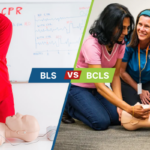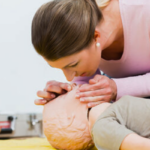
- Last Updated On: May 29, 2024
Knowing CPR Steps Can Help Save Lives
Performing cardiopulmonary resuscitation (CPR) on someone who isn’t showing signs of breathing can help resuscitate them until the arrival of emergency services. CPR works on a person’s blood circulation while waiting for professional help to arrive. CPR training is essential so you can perform it as soon as it’s needed.
Regardless of no prior experience or knowledge in first aid and CPR you can save a life when you get online CPR training.
When a person shows no signs of circulation and you initiate CPR, you may double or triple their survival chances. This guide is a visual step-by-step breakdown of how to perform CPR and you can learn more about it when you get online CPR training.
CPR Steps: Quick Reference
The purpose of CPR on an adult is when they are not breathing or starts gasping. Also, use CPR when an adult doesn’t respond to questions or taps on their shoulder. The warning sign in children is when they stop breathing normally or stop responding.
Ensure that the area is secure and then perform the following CPR steps:
- Dial 911 or ask somebody else to do it
- Gently lay the person on their back and open their airways
- Examine for signs of breathing. If there are none, start CPR
- Perform 30 chest compressions
- Repeat until the arrival of an AED or ambulance
CPR Step by Step
Before you are clear to perform CPR on an adult, implore the following preparatory steps:
Step 1: Call 911
You have to first locate things that may put you in danger. These may include falling building work, fire, and traffic. The next thing to do is check on the person to see if they need help by tapping their shoulder. If they are non-responsive, call 911 or ask a bystander to dial 911before using CPR. Also, ask the bystanders to go into the nearby buildings and search for an AED.
Step 2: Set Up the Person on Their Back and Open the Mouth
You need to lay the person down carefully on their back before kneeling beside their chest. Gently lift their chin to tilt their head back. Open their mouth and clear any obstructions such as food or vomit. Remove any loose obstruction and leave alone that which is not loose. It will only get pushed further down the mouth.
Step 3: Check for Breathing
For the next 10 seconds, place your ear next to the person’s mouth. You are clear to use CPR if you don’t hear any breathing or hear periodic gasps. When someone is knocked out but still breathing, don’t use CPR. Instead, check if they don’t have a vertebrae injury, then you can set them up in the recovery position. Keep on monitoring their breathing and use CPR when they cease breathing.
CPR Steps
Use the following steps to perform CPR:
Step 4: Carry Out 30 Chest Compressions
Put on the victim’s chest one arm on top of the other and clasp them together. Using the heel of your hand and straight elbows, exert pressure hard and fast in the center of the chest, just slightly beneath the nipples. Make 2 inches deep pushes while compressing their chest at least 100 thrusts per minute. In between the compressions, allow the chest to rise fully.
Step 5: Perform Two Rescue Breaths
After you have cleared their airflow, place your mouth completely over theirs, whilst pinching their nose, and blow their chest to make it rise.
Step 6: Repeat
Repeat the cycle starting with the chest compressions. Upon the arrival of an AED, keep using CPR while the AED is being set up.
Read More: What are the 7 Steps of CPR?






